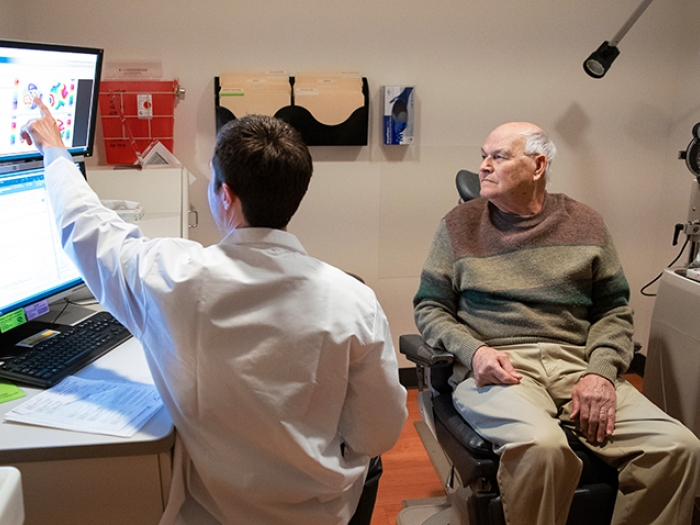The finding is a promising step forward in understanding eye growth – and potentially fixing near- and far-sightedness.
2:40 PM
Author |

Those with a rare genetic condition called nanophthalmos have abnormally small eyes whose internal structures – including the size of the lens – are otherwise normal.
LISTEN UP: Add the new Michigan Medicine News Break to your Alexa-enabled device, or subscribe to our daily updates on iTunes, Google Play and Stitcher.
The condition can cause a host of vision-related problems including amblyopia ("lazy eye") or strabismus ("cross eyes") in children, retinal detachments and glaucoma.
By advancing ideas first cultivated at University of Michigan Kellogg Eye Center, a team of eye and genetics experts is the first to identify a gene mutation behind nanophthalmos and to describe a new pathway for eye growth and development.
Their discovery could offer the opportunity to identify children with the disease earlier and intervene to protect their vision.
SEE ALSO Gene Therapy Treatment Targets Rare Mutation Tied to Blindness
The eyes' small size in people with nanophthalmos results in severe farsightedness, which, when not diagnosed and treated early with corrective lenses, can permanently compromise vision.
A normal-sized lens in a small eyeball can also hinder the flow of fluid in the eye. This can cause complications like retinal detachments and glaucoma, including a rare form called angle closure glaucoma, where blockages in eye drainage can suddenly elevate the pressure of fluid inside the eye.
Nanophthalmos also makes ocular procedures, such as cataract surgery, risky.
The study, published in PLOS Genetics, is the first to link nanophthalmos with a variant or mutation in the gene, myelin regulatory factor (MYRF), that causes the gene to produce an abnormal protein.
We know that the eye continues to grow after birth so there are opportunities to intervene early to screen for nanophthalmos and prescribe glasses. Eventually we hope to develop genetically-targeted treatments as well,Lev Prasov, M.D., Ph.D.
The team also established an interaction between MYRF and another gene implicated in nanophthalmos, TMEM98, describing a new pathway for eye growth and development.
MYRF has been a primary research focus of the paper's lead author, Lev Prasov, M.D., Ph.D., since his recent residency at Kellogg Eye Center.
An ophthalmologist and geneticist, Prasov will return to U-M this fall following an ophthalmic genetics fellowship at the National Eye Institute.
With mentorship from Julia E. Richards, Ph.D., professor emerita at Kellogg Eye Center, and Sally Camper, Ph.D., acting chair of the Department of Human Genetics, Prasov led the multidisciplinary team of experts that included study co-lead authors Michelle Brinkmeier, M.S., a senior research associate in human genetics, and Sarah Garnai, now a medical student at Harvard University.
The study builds on Richards' legacy of working with a large family with numerous occurrences of nanophthalmos and as the first to map the location of the gene responsible for the condition to a specific area in the genome called the NNO1 locus.
A Compelling Misspelling
"There are numerous steps involved in making a gene-disease connection," Prasov says. "One is to confirm that whatever genetic mutation you suspect is not unique to members of one bloodline but occurs in unrelated individuals as well."
For their study, the team augmented the information from NNO1 with that of an unrelated patient with nanophthalmos to ensure they started with a comprehensive sample.
Using samples from both the related and unrelated patients, the team sequenced numerous genes from within the region of the genome where the nanophthalmos gene is known to originate, looking for mutations or "misspellings" that might be driving the development of the disease.
"During that process, MYRF rose to the top of the list of compelling misspellings," Prasov explains.
While work remains to fully understand the nature of MYRF's mutation, the team determined that it occurs during the splicing stage of transcribing DNA into RNA.

Additional steps in validating the MYRF mutation as the culprit included segregation analysis to confirm that family members with nanophthalmos had the mutation (and that healthy subjects did not), and examining post-mortem ocular tissue to confirm that the MYRF protein is indeed made within eye tissue –largely within the retinal pigment epithelium, a layer of cells that nourishes the visual cells in the retina.
SEE ALSO To Spot Vision Trouble in Premature Babies More Often Shift Focus to Telemedicine
In the course of genetic sequencing and developing various mouse models with and without the MYRF mutation, another important link was established.
"We found that MYRF binds with and regulates the expression of another gene called TMEM98, previously implicated in nanophthalmos," Richards says. "In mouse models without MYRF, we saw a sharp decline in the expression of TMEM98, further evidence that a MYRF/TMEM98 interaction causes nanophthalmos."
Clinical Implications
The findings point to a brighter future for children born with nanophthalmos.
"We know that the eye continues to grow after birth so there are opportunities to intervene early to screen for nanophthalmos and prescribe glasses," Prasov says. "Eventually we hope to develop genetically-targeted treatments as well."
Genetic counseling and screening are recommended for families at hereditary risk of nanophthalmos.
"In addition to understanding the ocular risks, mutations in the MYRF gene have also been linked to an increased risk of congenital conditions, including diaphragmatic hernia, cardiac and urogenital anomalies and a rare form of encephalopathy," Richards says.
Prasov also sees the potential of this discovery to address a much more common vision problem. "While nanophthalmos results in an underdeveloped eye, myopia, or nearsightedness, occurs when the eye grows too much," he explains.
Myopia impacts 30 to 40 percent of adults in the U.S. and Europe and up to 80 percent of adults in Asia.
"It's exciting to imagine how this new knowledge about eye development may open a door to new interventions to address a major worldwide public health issue," he says.

Explore a variety of health care news & stories by visiting the Health Lab home page for more articles.

Department of Communication at Michigan Medicine
Want top health & research news weekly? Sign up for Health Lab’s newsletters today!





